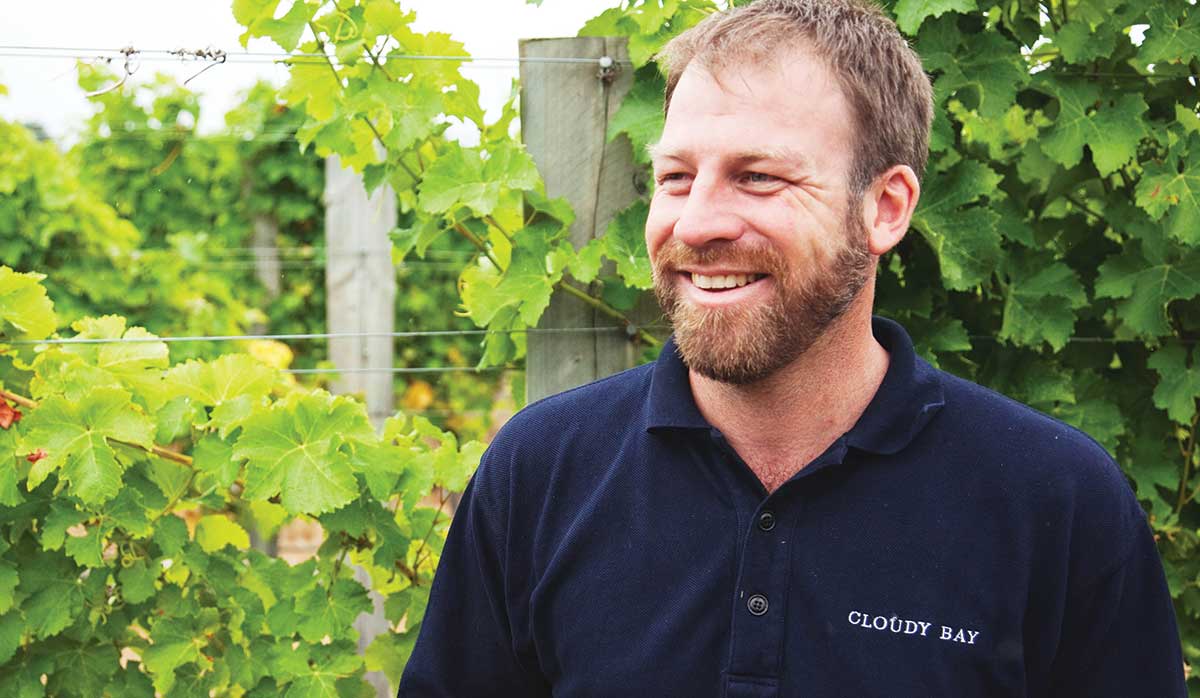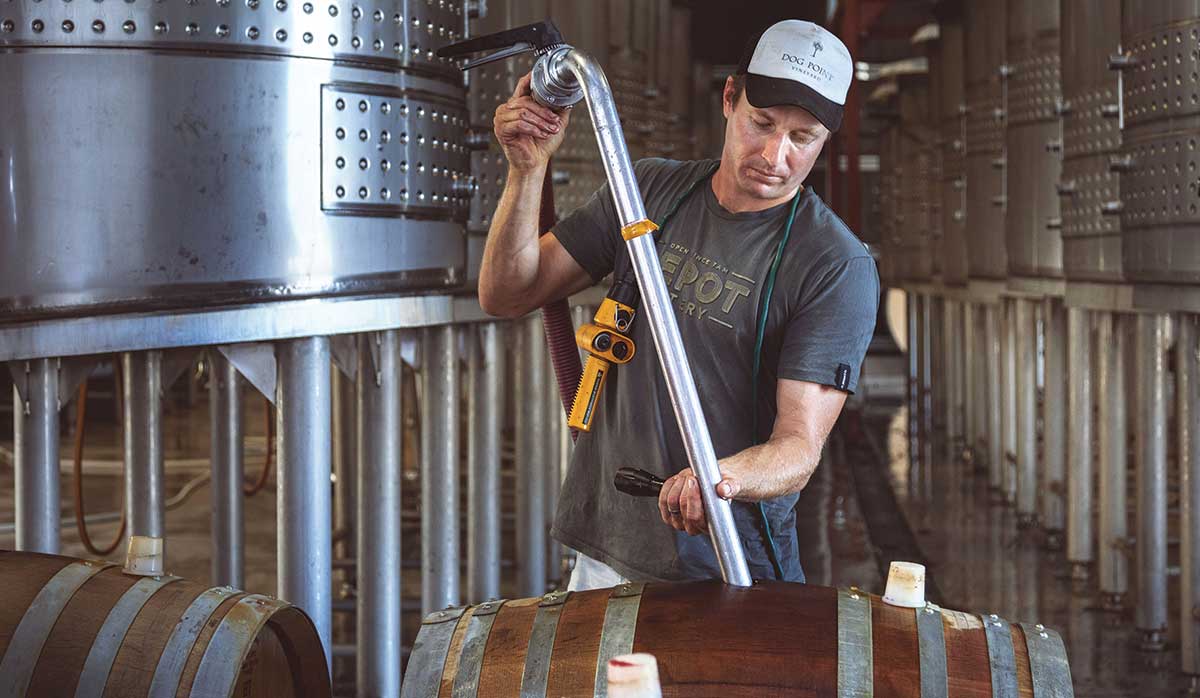If you’re partial to a glass half full, then the story of New Zealand wine in a global pandemic is certainly one to savour. Exports from July to October are up 19 percent on the same period last year, and New Zealand Winegrowers (NZW) Chief Executive Philip Gregan is increasingly confident the industry will hit its $2 billion export target by the end of the year. “We anticipate it will be very, very close.”
It’s not what the industry expected in March, when Covid-19 saw populations around the world go into lockdown, New Zealand’s borders close, and vintage progress nervously under stringent Alert Level 4 restrictions. Back then, NZW revised its budgets, assuming a 10 percent reduction in wine sales from March to January 2021, or a 25 percent reduction under a worst case scenario. Nationwide, many wine company accountants were doing the same thing, sharpening pencils, adjusting bottom lines and assuming grim days ahead.
“We had to plan for the worst case at that time,” says Philip. “And nobody would have suggested then that in the July to October period, our exports would be up 20 percent on last year.” In fact, if someone had stood up in the meeting and said ‘we’ll boost our wine sales’, they’d probably have been told to move on, he says.
But that’s what happened, with surging demand and shortening supply seeing new vintage wines shipped earlier than ever before. In October, 90 percent of the Rosé and Pinot Gris shipped from New Zealand was from the 2020 vintage, while for Sauvignon Blanc, that share lifted to 94 percent. Between May and October, export shipments for latest vintage Sauvignon Blanc were 50 percent higher than at the same time last year.
The success of New Zealand wine is unique in these extraordinary times, says Villa Maria’s Chief Global Sales and Marketing Officer Matt Deller, MW, talking of two “very strong supplier trends” at play around the world. “One is buy local…The second trend, and the only other recurring national trend, is buy New Zealand,” he says. “We are not just riding the wave of this surge in global demand, because invariably in most countries that surge in demand has been hyper focussed on local wines. But New Zealand is the one exception.”
There’s also a certain something about Marlborough Sauvignon Blanc, Matt says. “Where there’s a whole lot of uncertainty, people are looking for certainty where they can find it. People overseas know that Marlborough Sauvignon Blanc is going to deliver a predictably excellent wine experience.”
Rabobank’s Q4 Wine Quarterly report, released late October, says New Zealand’s wine export growth is bucking a global trend, with lower volume and value export sales among many of the world’s major wine-exporting countries. “The pandemic has created massive challenges for the wine industry, mainly due to the difficulties facing the on-premise channel,” says RaboResearch wine analyst Hayden Higgins. However, New Zealand producers have benefitted from increased home wine consumption, driving strong retail demand in key markets.
Philip notes that it is a tougher time for boutique companies without access to grocery (see page 19) “but they are not just sitting there and saying it’s tough”, he says. “What they are doing is responding dynamically; seeking other ways to get into the market.” Meanwhile, the latest data from Statistics New Zealand shows the domestic hospitality sector is rebounding, and in October, credit card spending in restaurants, cafes and on takeaways was up 8.8 percent compared with October 2019, with the second highest monthly spend in more than 20 years.
Bucking the trends
In the 12 months to September 2020, Villa Maria shipped 13 percent more wine than budgeted for before the pandemic hit. “We ended up over-delivering on the budget and massively over-delivering on the Covid forecasts,” says Matt, talking of growth driven largely by the UK, Ireland, Canada, Russia and Australian markets.
That success is unprecedented and unexpected, he says. “Across a team that has experienced all sort of crises and recessions over the years, this was a new one on us. I guess what we were not prepared for was that massive surge in grocery demand and e-commerce demand globally.”
He puts the buy New Zealand trend down to “New Zealand sentiment and the Jacinda effect”, as well as the pandemic fuelling “mission buying” when it comes to wine. People don’t linger at the shelves, browsing unknown brands, but instead get in and out fast, clasping a wine they know. “In any time of crisis there’s a desire for safety or a feeling of familiarity or reliability,” Matt says. “For Villa Maria, years and years of delivering exceptional quality at all price points has really paid off in our key markets.”
Sauvignon Blanc isn’t the only variety doing well, he notes. “Everything has grown, but Sauvignon Blanc has grown more.” The industry is already seeing a drop in the “depth and frequency” of promotions, and in 2021 Villa Maria will slightly lift its price in the UK for its Private Bin wines, “to realise what we call fair value”, he says. “We know that we are under-priced right now.”
The UK market is also seeing premiumisation, with a strong interest in higher tiers of wines. That’s partly about a ‘treat yourself’ mentality around “affordable luxury”, which Villa Maria saw at play in the last recession as well, he says. But it is also because people accustomed to paying $50 for a wine at a restaurant may choose to pay $30 for a wine at a supermarket, he adds.
While that’s benefitting retail channels, Villa Maria is eager to see on-premise bounce back. “It’s a really important channel for wine in general,” he says. “So many people do get into wine in wine bars and restaurants and hotels, and there are so many great people in the hospitality industry globally that have great affection for Villa Maria and we for them. We care about them and hope that they can continue doing what they love.”
The Sauvignon Saviour
Cloudy Bay is also seeing steady growth in its key markets, with sales up on last year, as retail growth more than makes up for the stall in on-premise, says Technical Director Jim White. They also have more wine to sell, thanks to an “exceptionally good harvest”, he adds. “We took a few deep breaths back in January, knowing we had our 2019s to bottle, trying to work out what was happening with the world.” But they didn’t foresee the strong upswing in demand. “I think collectively everyone has been surprised by the buoyancy, particularly of Sauvignon Blanc, in the marketplace.”
Jim puts the growth down to a combination of factors, including New Zealand’s Covid status, a “great vintage”, and the high quality and good value of Marlborough Sauvignon Blanc in the grocery channel. “I think people do tend to return to the things they trust and brands they know in a time of crisis.”
Cloudy Bay’s Chardonnay, Pinot Noir and Pelorus sparkling wine haven’t fared as well in all markets, because they’re more dependent on on-premise, says Jim. “Losing essentially three months of sales of that on trade wine is harder to make up for… The big question is ‘what will happen to the on-premise now?’”
 |
|---|
|
Jim White. |
Marlborough organic producer Dog Point Vineyards has always tried to strike a balance between on trade and retail, says General Manager Matt Sutherland. When Covid hit they had no idea what to expect, but assumed it would impact adversely on sales. But they are “cautiously optimistic”, having fared better than they predicted. “Though with a new wave of lockdowns and Christmas approaching - the busiest time of the year in market - sales could be unpredictable.” It remains an environment “where you have to be flexible and willing to change plans every day,” he says. “I think like most we hope for the best and plan for the worst.”
Dog Point has found that, in general, smaller countries that were able to lock down their populations “easier and earlier” have bounced back the quickest, including New Zealand, Australia, Hong Kong and Singapore. But the biggest surprise has been the amount of new inquiries from new markets, Matt says. “The level of interest is there and, regardless of the environment, people are engaging and looking for opportunities.”
It is pleasing to see Sauvignon Blanc performing so well, as an approachable variety with a strong reputation, he says. “When it is left up to the individual to buy what they want - without any advice or suggestions, be that a sommelier or wine merchant - they gravitate to what they know and trust,” he says. “I think for me it has reaffirmed the strength of the New Zealand brand and the quality of wine coming from across the country, in particular Sauvignon Blanc.”
And he warns that the region needs to take care with that golden goose, ensuring a judicious amount of bulk wine sold abroad. “There is a place for bulk wine, but we just need to stop celebrating it.” New Zealand can take pride in the fact people love Sauvignon Blanc from New Zealand, and in particular Marlborough, he says. “So why would we want to put ourselves in a position where we risk that reputation?”
Dog Point is more heavily reliant on its distributors and their teams than ever, and the “really good operators have shone through in these tough times”, Matt says. Despite the better than predicted sales, there are plenty of challenges. “Budgets and allocations become impossible as the situation changes daily. Flexibility and communication is paramount more than ever,” he says, admitting he is now constantly on the phone. Shipping timeframes and stock control is tough to navigate, he adds. “There are lots of delays and there is no consistency from day to day, so it is hard to know whether distributors should be stocking up or stocking down.”
 |
|---|
|
Matt Sutherland. |
Indevin Group Chief Executive Duncan McFarlane says Marlborough Sauvignon Blanc demand has been stretching beyond supply for some time, and Covid-19 accelerated that imbalance. “Putting Covid to one side, we were getting to critical inventory levels.”
He says the company didn’t know what to expect when Covid put the country in lockdown, “but we planned for the worst”. They devised vintage scenarios for different levels of disruption, including falling revenue and the potential shutdown of harvest. “Our focus was navigating our way safely and successfully through harvest, while keeping in very close contact with our customers.”
They assumed it was “more likely than not” that there would be disruption to demand, having already seen a stall in the on-premise space, says Duncan. “We knew that the primary channels we operate in would still be open – which is retail - but we didn’t anticipate the spike in demand that we ended up seeing.”
When that spike revealed itself, Indevin swiftly moved inventory already in market and got extra wine on the water. “We were fortunate because we planned on, and had been working on, a pretty decent increase in supply for Marlborough Sauvignon Blanc for vintage 2020,” he says. Instead of using that in new markets, as originally planned, they met demand from existing customers, topping it up with the purchase of additional wine.
Sauvignon’s demand trajectory is a great news story, but while all producers and exporters would be keen to increase price, it’s vital that the companies correctly read the “elasticity”, in order to safeguard demand, he says. The average price has already been pushed up, as lower priced products disappear from shelves, “and the whole tide rises”, he says. The greater challenge is to increase the headline price. “We’ll be trying as hard as any other business to increase value, but my own opinion is first and foremost we have to ensure that we can sell our wine… We also don’t know what the impact will be in our core markets when the economic impact of the pandemic actually bites.”
Tim Lightbourne, Co-founder at Invivo & Co, says the past six months have been the biggest since their 2008 launch. “Our brands are growing in all of our focus export markets and we export 80 percent of our wines, so this has been a major driver,” he says. The increase is driven largely by demand from the UK, Ireland, USA and Canada. “Sales of Graham Norton and Invivo X, Sarah Jessica Parker wines in the UK and Ireland alone have increased by 260 percent from April to September 2020,” he says. “With more people drinking at home, our retail partners are seeing an increase in demand which has offset the loss in on-premise business.” But he says they’re looking forward to the on-premise bouncing back, “as this is an important channel for our business and we’re supporting our partners where best we can”.
Philip Gregan says the export outcome for New Zealand wine is “beyond anyone’s best case scenario”. And the longer the change in consumer behaviours persist, the greater the chance that they become embedded for the long term, he adds. “That is providing more certainty about the future.”










